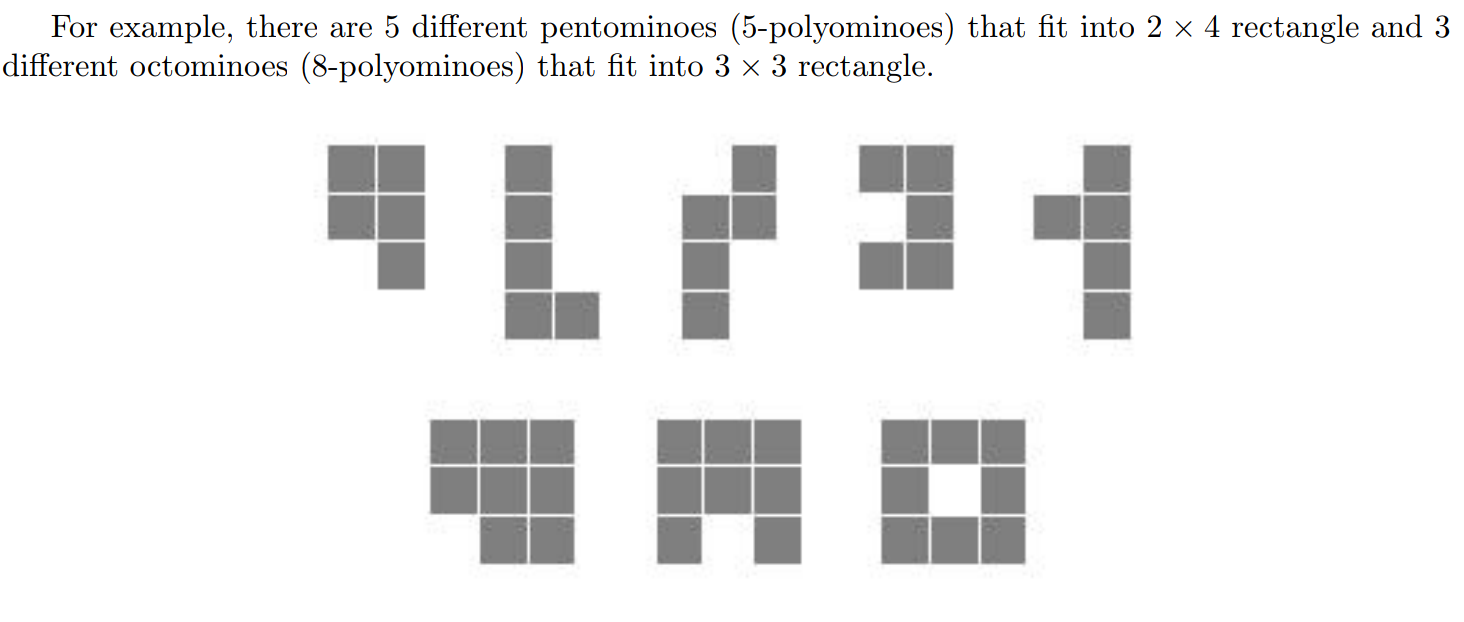1
2
3
4
5
6
7
8
9
10
11
12
13
14
15
16
17
18
19
20
21
22
23
24
25
26
27
28
29
30
31
32
33
34
35
36
37
38
39
40
41
42
43
44
45
46
47
48
49
50
51
52
53
54
55
56
57
58
59
60
61
62
63
64
65
66
67
68
69
70
71
72
73
74
75
76
77
78
79
80
81
82
83
84
85
86
87
88
89
90
91
92
93
94
95
96
97
98
99
100
101
102
103
104
105
106
107
108
109
110
111
112
113
114
115
116
117
118
119
120
121
| #include <iostream>
#include <algorithm>
#include <set>
using namespace std;
struct Cell{
int x,y;
Cell(int x=0,int y=0):x(x),y(y){}
bool operator < (const Cell &A) const{
if(x==A.x)
return y<A.y;
else
return x<A.x;
}
};
int dx[]={0,0,-1,1};
int dy[]={-1,1,0,0};
const int maxn=11;
set<set<Cell>> poly[maxn];
int ans[maxn][maxn][maxn];
inline set<Cell> standard(const set<Cell> & temp){
int mx=temp.begin()->x;
int my=temp.begin()->y;
set<Cell> res;
for(set<Cell>::iterator it=temp.begin();it!=temp.end();it++){
mx=min(mx,it->x);
my=min(my,it->y);
}
for(set<Cell>::iterator it=temp.begin();it!=temp.end();it++){
res.insert(Cell(it->x-mx,it->y-my));
}
return res;
}
inline set<Cell> rotate(const set<Cell>& temp){
set<Cell> res;
for(set<Cell>::iterator it=temp.begin();it!=temp.end();it++){
res.insert(Cell(it->y,-it->x));
}
return standard(res);
}
inline set<Cell> flip(const set<Cell>& temp){
set<Cell> res;
for(set<Cell>::iterator it=temp.begin();it!=temp.end();it++){
res.insert(Cell(it->x,-it->y));
}
return standard(res);
}
void add(const set<Cell>& s,const Cell& cell){
set<Cell> t=s;
t.insert(cell);
t=standard(t);
int n=t.size();
for(int i=0;i<4;i++){
if(poly[n].count(t))
return;
t=rotate(t);
}
t=flip(t);
for(int i=0;i<4;i++){
if(poly[n].count(t))
return;
t=rotate(t);
}
poly[n].insert(t);
}
void sol(){
set<Cell> start;
start.insert(Cell(0,0));
poly[1].insert(start);
for(int i=2;i<=10;i++){
for(set<set<Cell>>::iterator j=poly[i-1].begin();j!=poly[i-1].end();j++){
for(set<Cell>::iterator k=(*j).begin();k!=(*j).end();k++){
for(int l=0;l<4;l++){
int nx=k->x+dx[l];
int ny=k->y+dy[l];
Cell t(nx,ny);
if(!j->count(t))
add(*j,t);
}
}
}
}
for(int i=1;i<maxn;i++){
for(int w=1;w<maxn;w++){
for(int h=1;h<maxn;h++){
int cnt=0;
for(set<set<Cell>>::iterator it=poly[i].begin();it!=poly[i].end();it++){
int mx=0,my=0;
for(set<Cell>::iterator it2=it->begin();it2!=it->end();it2++){
mx=max(mx,it2->x);
my=max(my,it2->y);
}
if(min(mx,my)<min(h,w)&&max(mx,my)<max(h,w))
cnt++;
}
ans[i][w][h]=cnt;
}
}
}
}
int main(){
ios::sync_with_stdio(false);
cin.tie(0);
sol();
int h,w,n;
while(cin>>n>>w>>h){
if(n==1) {
cout << 1 << endl;
continue;
}
cout << ans[n][w][h] << endl;
}
return 0;
}
|
